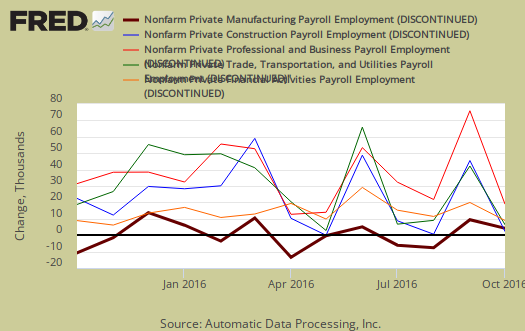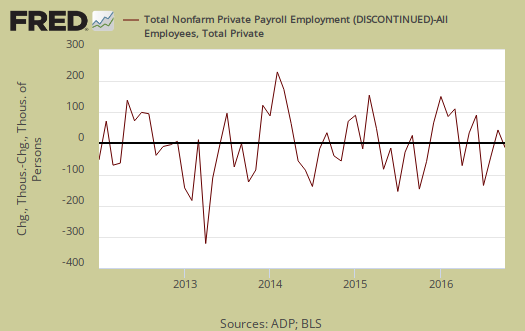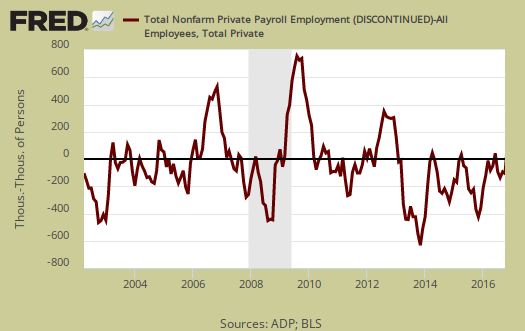ADP's proprietary private payrolls jobs report gives a monthly gain of 147,000 private sector jobs for October 2016. The reason was a loss of 15,000 construction jobs as well as manufacturing and education. September's ADP report was revised upward significantly, from 154,000 to 202,000. Overall, it is possible this report indicates the pace of job growth is slowing, rarely a good thing. This report does not include government, or public jobs. The official BLS employment report will be released on Friday.

ADP's reports in the service sector alone job gains were 165,000 private sector jobs. The goods sector lost -18,000 jobs. Within the goods sector, construction was hammered with a -15,000 job loss, natural resources & mining lost -2,000 and manufacturing shed yet another -1,000. Within the services sector, professional/business services jobs grew by 69,000. Trade/transportation/utilities gained 17,000 jobs. Financial activities payrolls added 18,000 jobs. Education and health services was low with a gain of 22,000 jobs, yet within this total, health care and social assistance added 34,000 jobs. This means that education probably lost a significant number of positions. Graphed below are the monthly job gains or losses for the five areas ADP covers, manufacturing (maroon), construction (blue), professional & business (red), trade, transportation & utilities (green) and financial services (orange).

ADP reports payrolls by business size. Small business, 1 to 49 employees, added just 34,000 jobs with establishments having less than 20 employees adding 14,000 of those jobs. ADP does count businesses with one employee in there figures. Medium sized business payrolls are defined as 50-499 employees, added 48,000 jobs. Large business added 64,000 to their payrolls, and companies with 1,000 or more workers added 64,000 of those jobs. Clearly October was the month for large companies to hire. ADP implies these companies stopped outsourcing for the season, veiled in the vague terminology, lessening impact the global economic environment had on large companies earlier in the year. ADP reports on just franchise employment and franchises added 25,200 jobs for the month. Franchises are places like auto dealerships, chain restaurants, etc. where the brand and products are licensed to a small business owner and the facility is not run by the main company themselves.
Below is the graph of ADP private sector job creation breakdown of large businesses (bright red), median business (blue) and small business (maroon), by the above three levels. For large business jobs, the scale is on the right of the graph. Medium and Small businesses' scale is on the left.

One of the more interesting aspects of the ADP report is the breakdown of the private sector by service producing and goods producing jobs. The service sector are disproportionately lower paying jobs as a whole in comparison to goods producing jobs, even while including the financial, professional and business services sectors are part of services. Below is the graph of ADP service sector (maroon, scale left) jobs against their goods production jobs (blue, scale right).

The ADP employment report, if it matches the BLS official unemployment report, would overall imply just barely enough overall enough job growth to keep up with population, as ADP reports just the private sector job growth. That would correspond with reports of a slowing economy, although Q3 GDP begs to differ.
The ADP private payrolls rarely matches the BLS monthly employment figures. The monthly BLS jobs survey (CES) has a 100,000 payroll jobs overall margin of error. ADP changed their methodology and now claim to match the BLS private payrolls, but only historically, after revisions. The below graph shows shows how many private sector payroll jobs, each month, ADP was off by in comparison to what the BLS reported. This is a monthly graph, not cumulative. As we can see, it's been rare where the two monthly reports get the exact same private payrolls growth numbers. When the below graph bar is negative, that means the BLS reported a larger number of private jobs than ADP did, when the graph bar is positive, it means ADP reported larger private payrolls. Again, compared are private sector jobs which is different from the BLS headline number. The graph will be updated with the BLS jobs figures.

Below is the cumulative difference between what the ADP reports as the private nonfarm payroll jobs vs. the BLS (ADP minus BLS). This line shows the divergence, over time in number of nonfarm private payroll jobs reported between the two reports. Due to annual revisions, ADP and the BLS are matching up once again in reported cumulative private sector jobs. Regardless, one cannot infer from the ADP report what the BLS figures will show on new releases. ADP claims their private payrolls cover 24 million jobs with 416 thousand businesses in the U.S. This represents about 20% of U.S. payrolls. The graph will be updated with BLS private non-farm payrolls data.

The graph below is the monthly change of private jobs as reported by ADP. At the absolutely bare minimum, the United States needs 1.2 million jobs per year, or 100,000 per month, total jobs, including public sector jobs, to keep up with additional new workers in the labor supply caused by population growth with the current still horrific labor participation rates.

The statistical differences between ADP and the BLS are fairly minor for the last couple of years. What does continue are large revisions as we see with ADP's September statistics. Time will tell, yet this report isn't too swank of an indicator, as is.
ADP themselves have some great visuals on their website for more perspectives, breakdowns and charts of their statistics. Here are our overviews from previous months, only graphs revised.

Recent comments